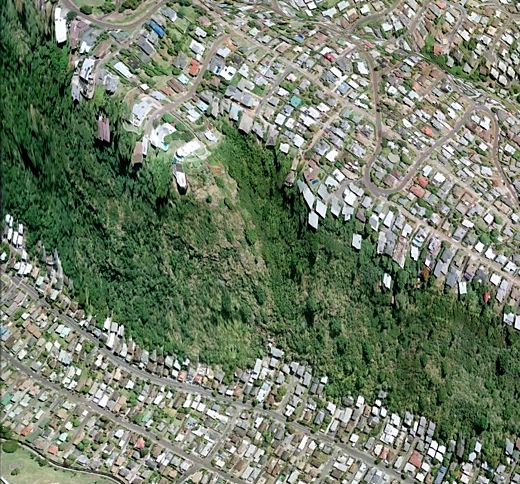 Image above: Suburban sprawl Google Earth view of suburban sprawl on Wilhelmina Rise overlooking Waikiki and Diamond Head. Selected by Juan Wilson.
[Editor's note: Great! Solar PV farm. Not so great - at the cost of more suburban sprawl on Kauai. The new language of the spec-development crowd is to make less obvious their interest in making a quick buck by slathering on terms like "sustainability", "green-jobs", "walkable communities" and "smart-growth". This particular scheme involves Ron Agor planning a 150 acre conversion of agland to suburban sprawl in an undeveloped area of Kapaa.]
By Leo Azambuja on 8 October 2010 in The Garden Island News -
(http://thegardenisland.com/news/local/article_92f28de4-d2ae-11df-904d-001cc4c002e0.html)
The Kaua‘i Planning Commission approved on Sept. 28 what could become the largest solar-energy facility in the state.
Image above: Suburban sprawl Google Earth view of suburban sprawl on Wilhelmina Rise overlooking Waikiki and Diamond Head. Selected by Juan Wilson.
[Editor's note: Great! Solar PV farm. Not so great - at the cost of more suburban sprawl on Kauai. The new language of the spec-development crowd is to make less obvious their interest in making a quick buck by slathering on terms like "sustainability", "green-jobs", "walkable communities" and "smart-growth". This particular scheme involves Ron Agor planning a 150 acre conversion of agland to suburban sprawl in an undeveloped area of Kapaa.]
By Leo Azambuja on 8 October 2010 in The Garden Island News -
(http://thegardenisland.com/news/local/article_92f28de4-d2ae-11df-904d-001cc4c002e0.html)
The Kaua‘i Planning Commission approved on Sept. 28 what could become the largest solar-energy facility in the state. In order to qualify for grants that could potentially cut construction costs in half, the solar company plans to finish the project by the end of the year.
“We think it’s a step forward in balancing the energy needs of the island, and a small step toward self-sufficiency,” said attorney Kurt Bosshard, president and sole member of Kapa‘a Solar LLC.
Drew Bradley, regional manager at REC Solar, the company contracted to install the solar structures, said the project will be larger than the one on Lana‘i.
“It’s a great chance for Kaua‘i to step out front with renewable energy,” he said. “It’s hard to imagine any opposition to a project like this.”
Bradley said the project will bring employment and money, besides being “great for the environment.”
The solar farm is planned to occupy four acres of a 165-acre property by Olohena Road, “just bellow the Ka‘apuni (Road) intersection,” Bosshard said.
If Kapa‘a Solar finishes the project by the end of the year, by law the company could qualify for a reimbursement of 50 percent of the construction costs said Bosshard.
“The project itself would generate millions of dollars in state and federal contributions,” he said.
This would allow Kaua‘i Island Utility Cooperative to purchase power from the facility at a reasonable rate, Bosshard said.
“We are actually ready to start should you approve this,” Bosshard said at the commission meeting.
Many REC workers showed up at the meeting to testify on behalf of the company, praising the company for taking care of them while off work, and saying they are eager and ready to go back to work.
Moloka‘i native Nathan Canyon, who has been on Kaua‘i for over two years working for REC, said he wants to see the island’s children benefiting from the project.
Location
Project architect Ron Agor said in the application that the area where the project is scheduled to be built is known as Kapa‘a Highlands.
Phase One of Kapa‘a Highlands is a 64-acre agriculture subdivision, and Phase Two is a 97-acre housing project with an affordable component, states the application.
Phase Two, located at the northwest corner of the Kapa‘a bypass road and Olohena Road, is in the process of a state Land Use Commission application to be re-zoned to urban from agriculture.
The land on phase two, states the application, is designated as urban center in the county’s General Plan.
The solar farm’s proposed location is near KIUC’s transmission lines, which makes the proposal “attractive to KIUC,” Agor says in the application.
“The purchase-power agreement between KIUC and Kapa‘a Highlands is currently being worked on,” the application reads.
Solar farm
The solar panels, mounted on posts and piers, will cover nearly the entire four-acre site. The panels average five to 12 feet off the ground, and will be mounted on a gentle slope from east to west, in an area not visible from Kuhio Highway or the bypass road.
The land where the panels will be mounted is zoned agriculture by the county and state, despite being fallow for approximately 15 years, when decades of sugar cultivation there ceased.
The soil is primarily silty clay, with a moderately rapid permeability, slow run-off and low erosion hazard. The U.S. Department of Agriculture Soil Conservation Service classifies the soil productivity as B, D and E. The classification system has a scale from A to E, with A being the most productive.
REC on Kaua‘i
The company in charge of the design and installation of the solar panels, REC Solar, has several plants spread throughout Arizona, California, Colorado, Hawai‘i, Oregon and New Jersey, according to the company’s website.
In Hawai‘i, REC has solar plants on O‘ahu, the Big Island and Kaua‘i. On the Garden Island REC has installed panels at Costco, Kukui Grove Center’s Longs Drug Stores and Waimea’s Pioneer Hi-Bred International Inc.
.
No comments :
Post a Comment